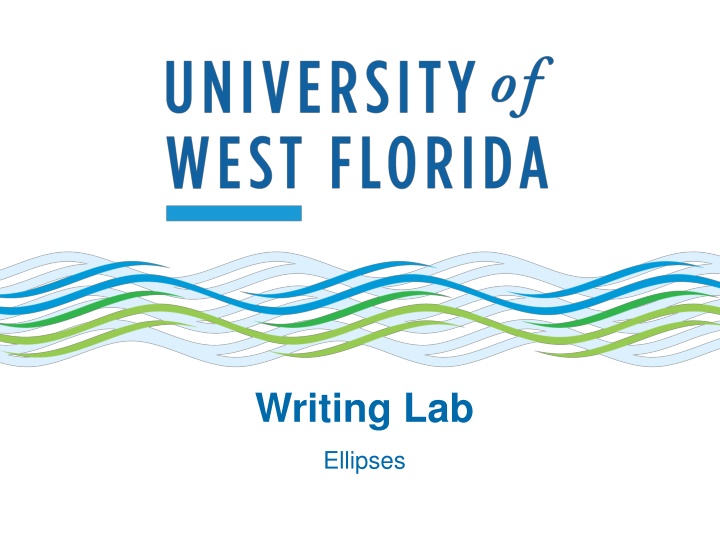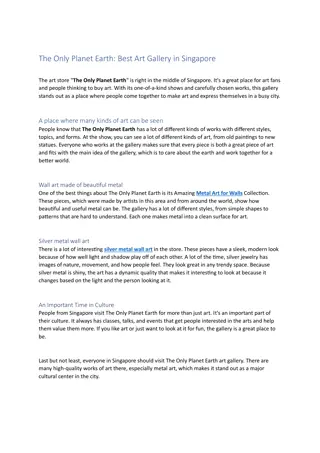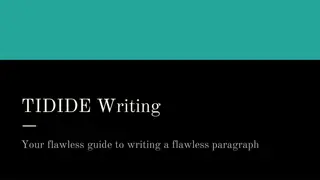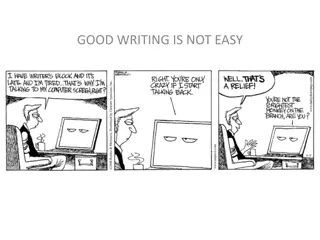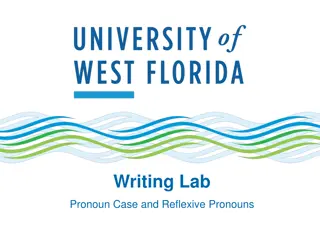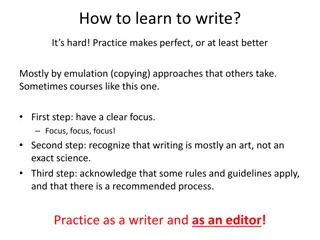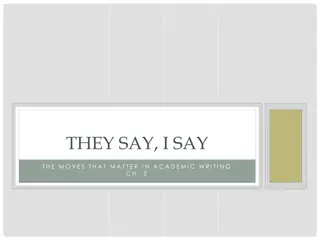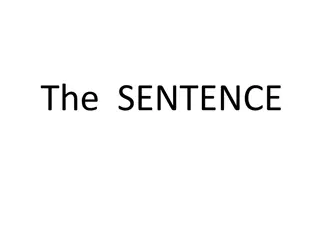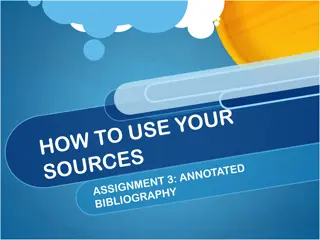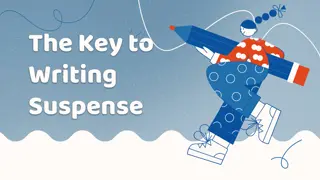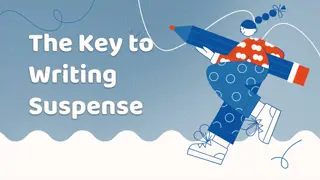Mastering the Art of Ellipses in Writing
Learn the proper use of ellipses in writing to indicate omitted material, create emphasis, or show a deliberate trailing off. Discover how to format ellipses correctly within sentences and quotations, ensuring grammatical accuracy and clarity in your writing.
Download Presentation

Please find below an Image/Link to download the presentation.
The content on the website is provided AS IS for your information and personal use only. It may not be sold, licensed, or shared on other websites without obtaining consent from the author.If you encounter any issues during the download, it is possible that the publisher has removed the file from their server.
You are allowed to download the files provided on this website for personal or commercial use, subject to the condition that they are used lawfully. All files are the property of their respective owners.
The content on the website is provided AS IS for your information and personal use only. It may not be sold, licensed, or shared on other websites without obtaining consent from the author.
E N D
Presentation Transcript
Writing Lab Ellipses
Ellipses Ellipses: a punctuation mark of three spaced dots (. . .) used to show an omission in writing or printing (Plural: ellipses).
Uses of Ellipses Use ellipses to show omitted material from a quoted passage in order to be fair to the author quoted and to maintain good grammar in the writer s own work. Your resulting passage should be grammatically complete and correct. Original: The boy s parents, frustrated with their son s declining grades, asked what they could do to help their child succeed. Quotation with omitted material: The boy s parents . . . asked what they could do to help their child succeed.
Uses of Ellipses cont. Original: An 18-year-old Virginia man was caught shoplifting at a Halloween Express costume store. He agreed to wear a Bert costume and hold a sign in front of the store that says, I got caught shoplifting at Halloween Express. The young man will do this for two days. The deal was worked out between the shoplifter and the store owner. The young man is lucky he is not being charged with a crime. Quote with omitted material: Rather than pressing charges, the owner of a Virginia costume store is requiring a shoplifter to wear a Bert costume and hold a sign in front of the store that says, I got caught shoplifting at Halloween Express. . . . The young man is lucky he is not being charged with a crime.
Uses of Ellipses cont. 2 Writers may use ellipses at the end of a sentence to emphasize a deliberate trailing off. Do you like my dress? Casey asked. Jonathan paused then began, Well . . .
Ellipses Format To show omitted material or a sentence trailing off, use three periods with a space before each ellipsis and a space after the last ellipsis ( . . . ). Studying literature . . . may broaden a student s world view. To show omitted material that is preceded by a complete sentence, use four dots: one dot immediately after the last word of the complete sentence and three more dots with a space before each ellipsis and a space after the last ellipsis. The sentence preceding the ellipses does not have to be the entire sentence from the source in order to be considered a grammatically complete sentence. To get the most out of college, students should be organized and plan their schedules. . . . To-do lists and calendars make great graduation presents.
Ellipses Format cont. For sentences that end with punctuation other than a period such as a question mark or an exclamation point, keep the punctuation and add three dots. How cold was it? . . . No one could function in that climate.
Examples of Omitted Material (from MLA Handbook) Original: Medical thinking, trapped in the theory of astral influences, stressed air as the communicator of disease, ignoring sanitation or visible carriers. (Barbara W. Tuchman, A Distant Mirror: The Calamitous Fourteenth Century [1978; New York: Ballantine, 1979, print; 101-102]). Ellipses in the middle: In surveying various responses to plagues in the Middle Ages, Barbara W. Tuchman writes, Medical thinking . . . stressed air as the communicator of disease, ignoring sanitation or visible carriers (101-102).
Examples of Omitted Material (from MLA Handbook) Ellipsis at the end followed by a parenthetical reference: In surveying various responses to plagues in the Middle Ages, Barbara W. Tuchman writes, Medical thinking, trapped in the theory of astral influences, stressed air as the communicator of disease . . . (101-102). This situation applies (for MLA only) when a quotation is taken from a source that has more information following the direct quotation. Quotation with an omission from the middle of one sentence to the middle of another: In discussing the historical relation between politics and the press, William L. Rivers notes that when presidential control reached its zenith under Andrew Jackson, . . . there were fifty-seven journalists on the governments payroll (7). Notice that because of the comma, this sentence is still grammatically correct.
Ellipses Reminders 1. Use three periods with a space before each ellipsis and a space after the last ellipsis ( . . . ). 2. Do not begin a quote with ellipses. 3. Never use more than three ellipses (or four ellipses if coinciding with the end of a sentence). 4. Always single space after ellipses and after the final period of a complete sentence that precedes ellipses. 5. MLA requires that ellipses be used if material is omitted from the end of a quotation. It does not require ellipses if material is omitted from the beginning of the quotation. 6. Turabian does not require that ellipses be used to represent omitted material at the beginning or the end of a quotation unless a textual studies method is being used. 7. APA does not require that ellipses be used to represent omitted material at the beginning or the end of a quotation unless, in order to prevent misinterpretation, the ellipses are needed to emphasize that the quotation was taken from a larger source.
Thats all, folks! This lesson is part of the UWF Writing Lab Grammar Mini-Lesson Series Lessons adapted from Real Good Grammar, Too by Mamie Webb Hixon To find out more, visit the Writing Lab s website where you can take a self-scoring quiz corresponding to this lesson
